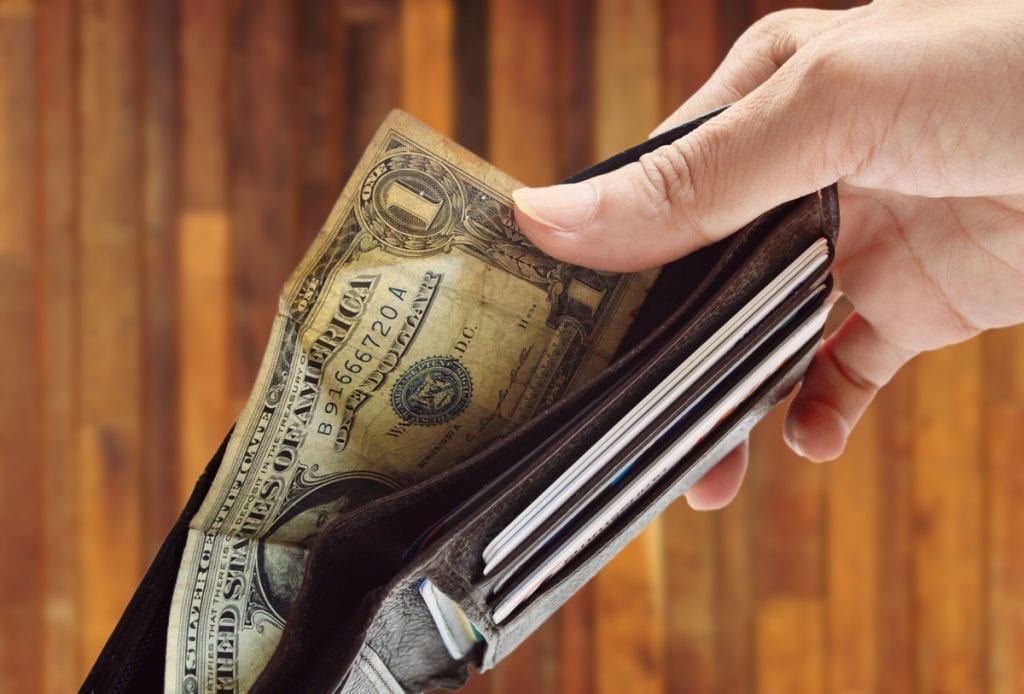How To Stretch Your Dollar Until Payday
Home > Debt Help Advice >
Stretching dollars until the next paycheck arrives has become a regular practice in America.
More than 38 million U.S. households are pinching pennies between paydays and the surprising fact about the money-mismanagement crowd is who’s in it.
Two thirds of the 38 million households living paycheck-to-paycheck are from middle-class America!
A 2015 survey conducted by Harris Poll said that one-third of the people making $75,000 or more and 25 percent of those making $100,000 or more, say they live paycheck-to-paycheck.
The ideal solution is to have an emergency fund set aside for just this sort of occasion, but that is a nearly forgotten part of financial planning. More than 25 percent of Americans have no savings at all and less than half believe they could handle a $500 financial emergency without having to borrow money or sell something.
That adds to the stress as you wait for the next paycheck and hope the car doesn’t break down or someone ends up in the emergency room. The short-term choice is to start scrimping here, there and anywhere you can find a place to save and the best place to start is the kitchen.
Turn Food Waste Into Food Saving $
It is ironic that food is the easiest place a family can go to stretch their dollars since that also is the area where there is the most waste. The average U.S. household throws out 25 percent of the food it purchases. For a family of four, that is between $110 and $200 a month that ends up in the garbage.
An even bigger waste of food money is dining out. The Bureau of Labor Statistics says that the average U.S. household spends about $220 a month eating out, which is more than enough to cover a week’s worth of groceries cooked at home.
So stretching your food dollars means eating at home and using perishable food and leftovers rather than pitching them in the garbage. Here are some simple steps to make it profitable and palatable:
- Make a menu: A menu helps confine spending. Make one that heavily features cereal at breakfast, peanut butter and jelly at lunch and casseroles or pasta at dinner, either of which can be used again the next night as a leftover.
- Drink tap water. If you’re trying to stretch dollars, bypass the aisle with soda, beer, juice and especially bottled water. You can save enough right here to make two or three meals.
- Take inventory. Perfectly good food sits in a freezer or pantry for weeks, sometimes months, without notice. Look over what you have and make it work with your menu.
- Buy generic. We can argue over the quality of store-brand items vs. national brands, but there is no argument over cost. Store brands are at least 25 percent cheaper. You need that 25 cents.
- Make a list. There are few places more tempting that a food store. What would it hurt to buy that box of brownies? Your wallet, when it’s already too thin! Only buy what’s on your list.
- Visit a food bank. There are a lot of good products that can be bought in bulk at inexpensive prices. Do it, and maybe you’ll save enough to make it easily to the next paycheck.
Long Term Solutions
Being careful with spending and food waste is a good, short-term way to stretch your dollars, but if you want to get serious about getting away from paycheck-to-paycheck living, you will have to consider tougher, long-term choices. That means attacking bills that come on a monthly basis, as opposed to the daily bills for food.
Those in a bind tend to look at two popular solutions: Pay your bills with a credit card or rob your 401(k) plan. Those seldom correct overspending habits. In fact, credit card debt is the prime reason people get into paycheck-to-paycheck existence.
So unless you’re will to enroll in a debt consolidation plan, the real long-term answer is to look at bills you pay once-a-month and see where you can eliminate, or at least reduce their impact.
Some of these suggestions may require lifestyle changes that are totally unappealing until you get to where the next paycheck arrives and all bills are paid … and there is even enough left over to start a savings account.
Choices Will Be Difficult
Some easy ways around the house to stretch your paycheck over the course of a month include:
- Cut the cable. For most people, dumping cable TV is at least a $100 a month bonus. There is life without ESPN and Showtime.
- Sell the cell. A $10 a month pre-paid cell phone does wonders for the bank account without killing the convenience of a cell phone. Go the cheap route.
- Bikes are a gas. Using a bicycle for transportation improves strength and fitness, leaves no mark on the environment and saves you a ton of money on car expenses.
- Carpool to work. If a bicycle doesn’t appeal, try doubling up with a co-worker or neighbor and cut transportation expenses in half.
- Do it yourself. Do your own cleaning, mowing, laundry, and any other household chores you might pay someone else to do. Mom was right: “If you want a job done right, do it yourself!”
The good news about dealing seriously with a paycheck-to-paycheck existence is that you realize how much waste there is in your spending and how creative you can be when the pressure is on.
Sources:
- Picchi, A. (2015, April 17) Earning $75,000 and living paycheck to paycheck. Retrieved from http://www.cbsnews.com/news/earning-75000-and-living-paycheck-to-paycheck/
- NA, (2014, August 15) Report on the Economic Well Being of U.S. Households in 2013. Retrieved from http://www.federalreserve.gov/econresdata/2014-economic-well-being-of-us-households-in-2013-executive-summary.htm
- Rawes, E. (2015, April 28) 3 Signs That You Spend Too Much Money on Food. Retrieved from http://www.cheatsheet.com/personal-finance/3-signs-that-you-spend-too-much-money-on-food.html/?a=viewall
- NA, (2012, October) Store-brand vs. Name-brand taste off. Retrieved from http://www.consumerreports.org/cro/magazine/2012/10/store-brand-vs-name-brand-taste-off/index.htm

